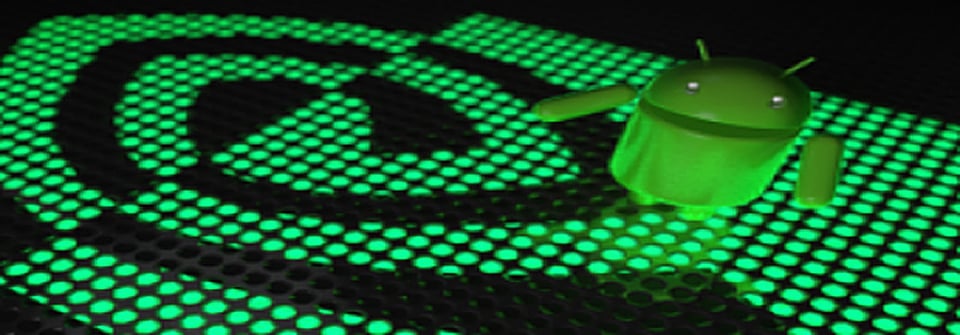We’ve been hearing a lot over the past few months about nVidia’s quad-core chipset, originally codenamed Kal-El. Today nVidia is officially announcing this chipset which is officially called Tegra 3. If you’ve read our previous articles regarding anything related to this, you should be excited.
Not too long ago, when we posted about the two nVidia whitepapers, we talked a little more in-depth about the quad-core chipset and that it’s actually 5-cores and not four. There are four main cores for all your high-powered usage but there is also a fifth core, dubbed a companion core, which will be used for low-power applications such as when your phone is idling of for when you make phone calls. Anything that doesn’t require multiple cores will use this single core which is being used to prolong battery power. If you happen to need two cores for something, the companion core shuts off and two of the four cores fire up to handle the task.
As you may already know, the first quad-core Android device, the Asus Transformer Prime tablet, is set to be released for the public to buy a few weeks after the November 9th event which will officially announce this product. The quad-core chip coming in this tablet, along with any other future quad-core Tegra 3 Android tablets also comes with a 12-core GPU inside. In gaming terms, this means some bad ass eye candy and game play with high frame rates to top it all off.
Last, but not least, most quad-core Tegra 3 Android devices should be coming with Android 4.0 (Ice Cream Sandwich) which comes with expanded game controller support. Once you have a quad-core Android device, you’ll literally have a portable console system regardless if it’s a phone or a tablet. Just HDMI-out and slap a controller on and you’re good to go.
Some people have been asking us whether or not Tegra 2 games will be compatible with Tegra 3 devices. We talked to our friends at nVidia about this and the answer is what we thought it would be. All Tegra 2 games will be completely compatible with Tegra 3 devices. So have no fear, once you get your Tegra 3 Android device, you’ll still be able to play all your Tegra 2 games on it. That is, of course, if you are not wasting hours of your life playing Tegra 3 games yet. You’ll see what I mean in the following articles.
Full press release below for your reading pleasure.
Developer Website: nVidia Tegra
NVIDIA Quad-Core Tegra 3 Chip Sets New Standards of
Mobile Computing Performance, Energy Efficiency
Tegra 3’s fifth ‘companion’ core enables ultra-low power consumption, while advanced quad-core processors drive record-breaking performance
SANTA CLARA, Calif.—Nov. 8, 2011— NVIDIA today ushered in the era of quad-core mobile computing with the introduction of the NVIDIA® Tegra® 3 processor, bringing PC-class performance levels, better battery life and improved mobile experiences to tablets and phones. The world’s first quad-core tablet with the Tegra 3 processor is the ASUS Eee Pad Transformer Prime.
Known previously by the codename “Project Kal-El,” the Tegra 3 processor provides up to 3x the graphics performance of Tegra 2, and up to 61 percent lower power consumption. This translates into an industry-leading 12 hours of battery life for HD video playback.
The Tegra 3 processor implements a new, patent-pending technology known as Variable Symmetric Multiprocessing (vSMP). vSMP includes a fifth CPU “companion”, specifically designed for work requiring little power. The four main cores are specifically designed for work requiring high performance, and generally consume less power than dual-core processors.
During tasks that require less power consumption – like listening to music, playing back video or updating background data – the Tegra 3 processor completely shuts down its four performance-tuned cores and, instead, uses its companion core. For high-performance tasks – like web browsing, multitasking and gaming – the Tegra 3 processor disables the companion
“NVIDIA’s fifth core is ingenious,” said Nathan Brookwood, Research Fellow at Insight 64. “Tegra 3’s vSMP technology extends the battery life of next-generation mobile devices by using less power when they’re handling undemanding tasks and then ratcheting up performance when it’s really needed.
The Tegra 3 quad-core CPUs are complemented with a new 12-core NVIDIA GeForce® GPU, which delivers more realism with dynamic lighting, physical effects and high resolution environments, plus support for 3D stereo, giving developers the means to bring the next generation of mobile games to life.
For the millions who play games on mobile devices, the Tegra 3 processor provides an experience comparable to that of a game console. It offers full game-controller support, enabling consumers to play games on their tablet or super phone, or connect to big screen HDTVs for a truly immersive experience. It also leverages NVIDIA’s award-winning 3D Vision technology and automatically converts OpenGL applications to stereo 3D, so consumers can experience 3D on a big screen 3D TV (via HDMI™ 1.4 technology).
The Tegra 3 processor provides the industry’s…
- Fastest web experience – with accelerated Adobe Flash Player 11, HTML5 and WebGL browsing, and an optimized Javascript engine
- Fastest applications – with blazing performance for multimedia apps, such as photo and video editing
- Fastest multitasking – for switching between common uses, such as playing music and games, and background tasks
- Fastest, highest-quality gaming – including new Tegra 3 processor-optimized NVIDIA Tegra Zone™ app games such as Shadowgun, Riptide GP, Sprinkle, Big Top THD, Bladeslinger, DaVinci THD and Chidori.
Highlights / Key Facts:
- The Tegra 3 processor redefines power consumption and mobile-computing performance with:
- The world’s first quad-core ARM Cortex A9 CPU
- New patent-pending vSMP technology, including a fifth CPU core that runs at a lower frequency and operates at exceptionally low power
- 12-core GeForce GPU, with 3x the graphics performance of the Tegra 2 processor, including support for stereoscopic 3D
- New video engines with support for 1080p high profile video at 40 Mbps
- Up to 3x higher memory bandwidth
- Up to 2x faster Image Signal Processor
- 40 games are expected to be available by the end of 2011, and over 15 Tegra 3 games are under development for Tegra Zone, NVIDIA’s free Android Market app that showcases the best games optimized for the Tegra processor.
- The Tegra 3 processor is in production. Developers can order the Tegra 3 Developer Kit to create applications for devices with Tegra such as tablets and super phones, at developer.nvidia.com/tegra.





